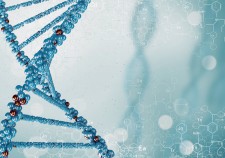 Stem cell research via Shutterstock
Stem cell research via Shutterstock
In most sports defensive players usually attempt to surround an offensive player — forcing her to back into her own side of the field. This is the general principle of a new drug that researchers at the University of Michigan have developed – one that block mouse cells’ ability to differentiate (become specialized) and thus force them to revert to a pluripotent state (where the cell has the capacity to become any other kind of cell in the body).
Stem cells have the ability to divide to create more stem cells or more specialized cells. They have the ability to replenish and repair damaged tissues. These cells provide scientists help in the drug discovery process and advance our understanding of cellular development.
Here is a refresher on what stem cells are:
- Totipotent, which means they can become any kind of body cell, including embryonic and placental tissue
- Pluripotent, meaning they can still become any kind of cell, including embryonic but not placental tissues
- Multipotent (i.e. mesenchymal) which means they can only become a certain set of cells – bone, cartilage, muscle and fat
- Unipotent, or that cells can only make a single type of cell
The genetic material of cells, our DNA, are wrapped around protein structures similar to spools, known as histones. Histones contain epigenetic markers which are similar to tags that provide information for the cells — telling them what to become. The new drug, called MM-401, essentially erased those tags, forcing cells to revert back to their original state as described in the journal Cell Stem Cell.
Epigenetics refers to the ability of a gene to be turned on or off, made active or inactive, without changing the underlying DNA structure. Epigenetic changes are a regular, natural occurrence which is under the influence of multiple factors such as age, environment, disease state. Epigenetics can determine the ultimate function of a cell through differentiation or it can have more deleterious effects which can result in the development of cancer.
“We’ve demonstrated that we don’t have to manipulate the pluripotent genes to get to the ground state, but rather that we can block all other options of where the cell ‘wants’ to go. Then the only option is going back to the ground, or naïve, or pluripotent state,” stated Yali Dou, PhD, lead author and an associate professor of pathology and biological chemistry at U of M.
Currently, scientists’ only access to pluripotent cells are from human embryonic stem cells – embryos that are left over in fertility clinics. It goes without saying that obtaining stem cells in this manner is rife with ethical dilemmas, controversy and is very highly restricted and regulated. Therefore, to date, the least differentiated cells for research have been multipotent cells, derived from human subjects.
External signals that promote cell differentiation include chemical messages secreted by other cells, physical contact with neighboring cells, and certain molecules in the microenvironment. The interaction of signals during differentiation causes the cell’s DNA to acquire epigenetic marks that restrict DNA expression in the cell and can be passed on through cell division.
There still much tweaking to be done before scientists are able to fully deploy cell-based therapy, otherwise known as regenerative medicine, as cures for diseases. Every advance adds to the foundation and hopefully brings us much closer to elucidating the highly dynamic nature of cellular development.
In most sports defensive players usually attempt to surround an offensive player — forcing her to back into her own side of the field. This is the general principle of a new drug that researchers at the University of Michigan have developed – one that block mouse cells’ ability to differentiate (become specialized) and thus force them to revert to a pluripotent state (where the cell has the capacity to become any other kind of cell in the body).
Stem cells have the ability to divide to create more stem cells or more specialized cells. They have the ability to replenish and repair damaged tissues. These cells provide scientists help in the drug discovery process and advance our understanding of cellular development.
Here is a refresher on what stem cells are:
- Totipotent, which means they can become any kind of body cell, including embryonic and placental tissue
- Pluripotent, meaning they can still become any kind of cell, including embryonic but not placental tissues
- Multipotent (i.e. mesenchymal) which means they can only become a certain set of cells – bone, cartilage, muscle and fat
- Unipotent, or that cells can only make a single type of cell
The genetic material of cells, our DNA, are wrapped around protein structures similar to spools, known as histones. Histones contain epigenetic markers which are similar to tags that provide information for the cells — telling them what to become. The new drug, called MM-401, essentially erased those tags, forcing cells to revert back to their original state as described in the journal Cell Stem Cell.
Epigenetics refers to the ability of a gene to be turned on or off, made active or inactive, without changing the underlying DNA structure. Epigenetic changes are a regular, natural occurrence which is under the influence of multiple factors such as age, environment, disease state. Epigenetics can determine the ultimate function of a cell through differentiation or it can have more deleterious effects which can result in the development of cancer.
“We’ve demonstrated that we don’t have to manipulate the pluripotent genes to get to the ground state, but rather that we can block all other options of where the cell ‘wants’ to go. Then the only option is going back to the ground, or naïve, or pluripotent state,” stated Yali Dou, PhD, lead author and an associate professor of pathology and biological chemistry at U of M.
Currently, scientists’ only access to pluripotent cells are from human embryonic stem cells – embryos that are left over in fertility clinics. It goes without saying that obtaining stem cells in this manner is rife with ethical dilemmas, controversy and is very highly restricted and regulated. Therefore, to date, the least differentiated cells for research have been multipotent cells, derived from human subjects.
External signals that promote cell differentiation include chemical messages secreted by other cells, physical contact with neighboring cells, and certain molecules in the microenvironment. The interaction of signals during differentiation causes the cell’s DNA to acquire epigenetic marks that restrict DNA expression in the cell and can be passed on through cell division.
There still much tweaking to be done before scientists are able to fully deploy cell-based therapy, otherwise known as regenerative medicine, as cures for diseases. Every advance adds to the foundation and hopefully brings us much closer to elucidating the highly dynamic nature of cellular development.

